Teaching your dog to come when called is no longer the way it was 20 years ago – when every obedience class taught it by leaving her on a sit-stay, walking across the room, and firmly commanding her to speed to a perfectly straight sit at the tips of your toes. Today’s educated trainers and knowledgeable dog owners recognize the value of making “Come” the happiest word in their dogs’ dictionary, and understand that truly reliable recalls can happen in the face of bouncing bunnies, dashing deer, cavorting cats, and flying squirrels.
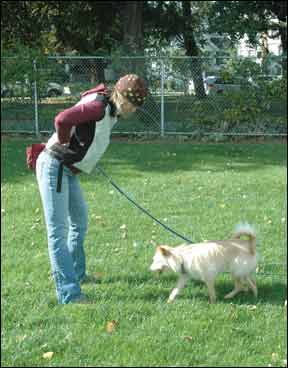
There was a time when trainers warned clients that they had to be more interesting than squirrels, cats, deer, and bunnies, if they wanted their dogs to come reliably when called. Good luck making yourself more interesting than a bounding Bambi!
In reality, the foundation for a solid recall starts long before Bambi makes an appearance, and doesn’t rely on you being a one man (or woman) canine entertainment center to successfully compete with significant distractions. It starts when you first introduce your dog to the “Come” cue. Successful recalls rely on a strong, classically conditioned association with high-value reinforcers. In other words, your dog learns that coming when called is so much fun that when you call her she doesn’t stop to weigh her options – she just automatically and gleefully comes flying to you.
Laying the Foundation
An enthusiastic automatic response to the recall cue requires that you lay a strong foundation from the very beginning, associating “Come!” (or whatever your recall cue) with really fun stuff. (See “Beware the Poisoned Cue,” top right). We do this in our basic good manners classes by teaching a “Run-Away Recall!” which looks like this:

1. In a safely fenced or enclosed environment, stash a supply of high-value treats in a bowl on a counter or table next to you. With your dog in front of you, say “Come!” (or your chosen recall cue) in a cheerful “We’re having a party!” voice and feed her a pea-size treat from the bowl.
Repeat several times, until your “Come!” cue elicits a happy “Where’s the treat?” response from her. You’ve now “charged” the “Come” cue, and are ready to try it out.
2. If you stand and face your dog when you call her (as done in old-fashioned training), you risk looking like an intimidating authority figure, which takes the fun out of “Come.” Instead, have your dog at your side (on- or off-leash), say “Come!” in a loud, cheerful, “We’re having a party” voice, and run away as fast as you can. The combination of your charged “Come” cue and your dog’s natural inclination to run after things that move should result in her following you as you run, hopefully at least at a trot, but preferably at a full gallop.
3. As she’s running after you, click your clicker (or use a verbal marker, such as the word “Yes!”). After you’ve run at least 10 to 15 feet or more, stop running and feed her the treat. Repeat several times until it’s clear she understands the game.

If her first response was a lukewarm trot, it may take several repetitions until she gets happy and excited enough about the game to gallop after you. You may need to increase the distance you run to give her time to get in gear. You may also need to increase your excitement to get her more excited, or decrease your enthusiasm if you think you may be scaring her with your energy level, which can sometimes happen with “soft” dogs.
4. Toss a few treats on the ground. While your dog is busy eating them, walk 10 feet away. As she finishes the last treat, call her and run away as fast as you can. Give her treats again when she reaches you. Repeat this exercise, gradually increasing the distance you walk away before calling her.
5. Start looking for opportunities where your dog is mildly engaged in something of relatively low interest to do your Run-Away Recall. When you can easily call her away from low-level distractions, try it with distractions of gradually increasing value.
Add toys to the mix if you think it will help. Some dogs will romp to you more enthusiastically for a squeaky toy or a game of tug than a bit of chicken; try both and use what works best for your dog. You can mix it up for dogs who like all three – the unpredictability of the reward can make it more fun and exciting for your dog. If you use the squeak of a toy to elicit a gallop, be sure to toss the toy for your dog when she gets there!
That’s your foundation – but your fun with recalls has only just begun. Add more fun games, like the ones on the next few pages, to generalize her understanding of the “Come” behavior to higher and higher levels of distraction. In this way, you can eventually train your dog to a level that enables you to trust her off-leash in safe, open areas.
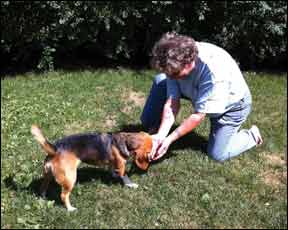
More Recall Fun
My personal favorite recall “add-on” is teaching an emergency “stop” cue. I use “Wait!” to pause my dogs in mid-step (see “Wait a Bit, Stay a While,” WDJ May 2001). Once their forward movement is stopped, it is much easier for them to hear and respond to their recall cue. I have also used a well-trained “Down!” as a stop cue. Again, when the dog’s forward motion is stopped, the recall happens more easily.
Leslie Nelson of Tails-U-Win in Manchester, Connecticut, is world-renowned for her “Really Reliable Recall” methods, available on DVD and in her book of the same title. Among other things, she advocates teaching an emergency recall cue that you charge with high-value treats and practice often in low-distraction environments.
Because this is a different word from your everyday recall cue, you don’t risk poisoning it accidentally. Then when you need it in a true emergency (dog running toward busy highway), it’s very likely to work. Pick a word that is easy for you to keep the positive association (some people use “Cookies!”) and remember to use it if and when you need it.
Every positive trainer has her own version of recall games. Here are some you can use with your dog:
Clarissa Bergeman, CPDT-KA, of Canine Company, LLC, in Round Hill, Virginia, suggests this version of an old obedience competition technique to get faster recalls: “As your dog is running in, whip a tennis ball or other favorite toy out of your back pocket and toss the object between your legs as your dog runs through to get it. It’s not just for small dogs. Coordinated handlers can lift one leg to let the dog run through and play this game with larger dogs, too!”
Laura Dorfman, CPDT-KA, PMCT1, of Kona’s Touch in Chicago’s North Shore, Illinois, invented a new game to play with her recently adopted Terrier-mix, Captain Jack Cricket:
“I sit with him right in front of me and cup both my hands together, playing a kind of peek-a-boo game in which he always finds a treat or toy in my hands. When he is a little farther from me, I get down on one knee and cup my hands together; when he sees this, he comes running for whatever yummy thing I have in my cupped hands.
“Twice, I’ve seen him him pick up something I didn’t want him to have, and I’ve cupped my hands together. each time, he dropped the item and came running. I started this game with him because I wanted to make sure he wasn’t becoming hand shy, but now I’ve taught him a few different behaviors that end with this great recall. It helps him love hands. It helps with targeting. And it’s given him an awesome recall.”

Cindy Mauro, CPDT-KA, of Cindy Mauro Dog Training in Bergen County, New Jersey, reminds dog owners that “Come” shouldn’t always mean an end to the fun stuff.
“When my dog is outside having a good time, playing with another dog or a person, I start with calling his name and letting him know I have something fabulous – steak, chicken, etc. – not an ordinary treat. In the beginning, I let him see the treats, or hear the crinkling bag. He runs to me, and I mark with “Yes”! and feed 1-2-3 treats, then immediately release him with ‘Go play.’
“Doing this randomly throughout the day teaches him that it’s great to come when I call his name, and I’m not always ending the ‘fun’ (play, chasing a squirrel etc.). The key is to do this often and randomly, with lots of repetitions of ‘treat / go play.’ I can get my dogs running to me even when they’re in the far end of the yard playing a rousing game of chase with each other!”
Susie Daily, CPDT-KA, from Pets In Motion in Wayne, Pennsylvania, offers a different perspective on recalls.

Photo by Jennie Clutterbuck
She says, “I like to do ‘Opportunity Comes,’ where you identify things your dog runs to you for anyway, and then just add the cue.
“For instance, before dinner time you know your dogs will run to you when they hear the sound of the food bin/bag/cupboard opening, so right before you open it, say ‘Fido, come!’ in an excited happy tone, then open the food and feed dinner! Reward is inherent and they start to perk up when they hear that cue.
“Other examples might be the sound of the ice cube dispenser on the fridge door (my dogs come running for that), the sound of the car keys, the sound of a squeaky toy, etc. Just be sure not to trick them! If it’s the car keys for instance, better take them for a ride. Anything you know your dog will run to you for anyway, just put it on cue!”
Sean Howard, PMCT1, of Up With Pup in Toronto, used the Premack Principle to teach a solid recall to his dog, Mikka. The Premack Principle says you can use a higher value/more likely behavior to reinforce a lower value/less likely behavior.
Howard says, “Mikka and I play the squirrel Premack game every day of every week. It was how we got recall in the first place; he is a Karelian Bear Dog and like many of his breed, predisposed to chasing things to the end of the earth.

“The game is simple. He targets a squirrel (now, even when he is off-leash), his body itching to launch. I wait a few seconds, and then call him. If he turns and comes at me in a full out run, I drop the leash and scream (mainly to give the squirrel a safe head start) for him to go ‘Get it!’ He tears off in a mad dash and comes prancing back proudly after he trees the squirrel. If he doesn’t choose to come to me when called, I say ‘Too bad!’ and we turn and walk the other way.
Estie Dallett, PMCT2, of Civil Dogobedience, based in Washington, D.C., recommends Round Robin Recalls, or what she calls “Multi-Person Random Order Recall Circle.”
She plays it this way: “At least three people spread out at a distance suitable to the level of the dog’s response-ability, then take turns cuing “come” in a randomly changing order. Often it makes an impression on the dog if you start off by doing two or three ‘circuits’ of cues in order, going left or right around the circle, then switch into random order. The dog will initially anticipate the next person to go to, but then will learn to pay attention to the person who actually said ‘Come.’
“Distraction levels can be increased by having the non-cuing people do increasingly active or silly dances or talking, applauding, or whatever. It’s important that all the people have equally fabulous treats. If not, a beginner dog may just hang around the person with the yummiest food. Of course, if the dog goes to a person who did not call her, then that person must ignore/turn their back on the dog.”
You can also enhance the recall response by having the person who calls the dog turn and run away to increase the enthusiasm of the dog’s response.
Recalls With Class
Trainers are also finding ways to make recalls more fun in the classroom setting. My training center, Peaceable Paws LLC, in Fairplay, Maryland, offers a recall class that makes use of the entire 80-acre farm, giving owners an opportunity to generalize their dogs’ recalls to the outdoors, in the presence of distractions such as horses, deer, squirrels, groundhogs, turkeys, and more.
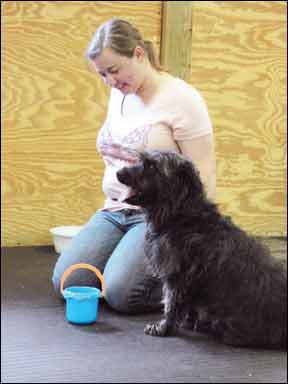
Jessica Miller, PMCT1, one of our Peaceable Paws trainers, likes to demonstrate the “Run Away Recall,” to show owners how silly they can be. She says, “When we give a big over-the-top performance, it seems that the class does better! It also helps everyone loosen up and give themselves permission to act silly. I like to give a prize for the person who gives the most exciting recall performance.”
Susie Daily, CPDT-KA, holds recall races in her classes. “I like doing recall races at the end of Manners 1, as long as all dogs are friendly and can tolerate it. Instructors/assistants run with the dogs on-leash to prevent any incidents.
“Two dogs are restrained by assistants at one end of the room. A finish line is marked at the other. Owners go across the finish line and wait to be told: ‘Ready, set, call your dog!’ Both call their dogs, and the one to get their dog across the finish line and into a sit first, wins. Then we race two more, until everyone has raced, then winners race each other. We do heats until we find the fastest recaller!”
Diana Foley, CPDT-KA, of Progressive Pet Training in Gaithersburg, Maryland, also holds friendly competitions in her classes, but instead of speed, she’s looking for the most enthusiastic recalls. “I like to have the dogs line up with their owners, and one at a time, the owners go across the room (I hold their dogs at the starting line) and call their dogs. We have a friendly competition for who can get their dog to come with the most enthusiasm. It helps the owners lighten up and be more silly and fun when calling their dogs, and the other owners observe and cheer them on. It makes for a fun environment where owners are having fun with their dogs rather than the stern and commanding “COME” that I’m sure we’ve all seen!”
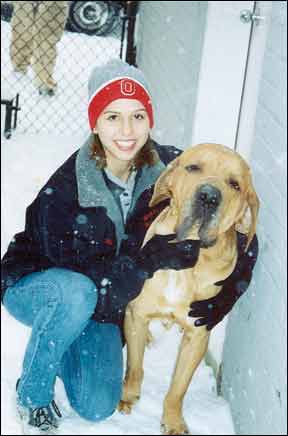
My personal favorite is the “Hidden Treasure” recall. Leave your dog in the house and set up a “treasure area” by hiding high-value reinforcers in your fenced yard, or along a hiking path. Hide some of your dog’s favorite toys as well as extra-tasty treats. With the treats hidden, bring your dog out to the treasure-laced area, off-leash if she’s ready for that, or on a long line if necessary. Call her. When she gets to you, run with her to the nearest hiding place and reveal the treasure. The combination of the fun run, followed by the appearance and delivery of the treats, will make this an irresistible game for your dog. She’ll be amazed that you can make marvelous reinforcers appear out of thin air!
Get Creative
One of the many things I love about positive reinforcement training is that it encourages trainers and owners to get creative with their training. No longer is there one “right” way to teach behaviors; there are as many ways as there are human brains to think them up.
The panoply of ideas described above for teaching your dog to come to you enthusiastically and fast when called demonstrates this – and these barely scratch the surface. We challenge you to come up with more fun ways to teach your dog to come when you call her. Meanwhile, remember to keep your recalls consistently fun and rewarding for your dog so that she’ll romp to you with enthusiasm, each and every time you call her.




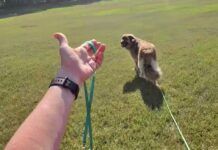


I’ve had my Black German Shepherd since she was 12 weeks old. She turned 3 this past July. We practice her recall daily. Sometimes with treats, often with just gushing praise. She’s awesome with it. She still has her “meh, its just you” moments, but by and large, she comes when she’s called and she always, always gets gushing praise…even when it takes her a moment or two. Because you know, sometimes its just seems like too much work to get off the couch when you’re called. 😉
Great information and good to be aware of different ways to set up a recall situation.
Tend to get stuck in ways we were taught before. I always felt the recall was a special training which needed to be done
as a very advanced and separate skill but can see now how it can and needs to be integrated into training as part of the whole picture.
Thank you.
Have been a subscriber of the WDJ but no dog at the moment but can always pass on good information.